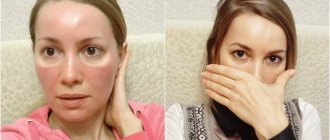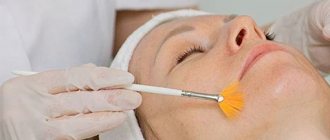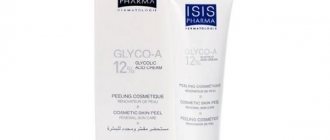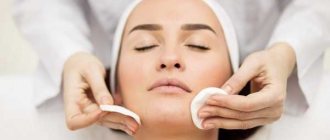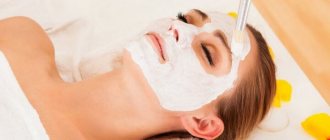Chemical peeling for the face (exfoliation) is a cosmetic procedure that allows you to renew the surface layers of the skin. With the help of weak acids, dying cells are dissolved and natural regenerative processes are stimulated. Due to this, the face becomes fresh and clean, pigment spots and minor defects disappear. Peels are often included in complex anti-aging programs, as they improve the penetration of other active ingredients into the skin, including hyaluronic acid.
Types and features of chemical peels
Chemical facial peeling procedures vary in the extent to which they affect the skin. The deeper it is, the more noticeable changes can be achieved. There are the following levels of exfoliation:
Surface cleaning.
The drug affects only the superficial layers of the epidermis, which contain no living cells. Such procedures are common, as they provide an opportunity to refresh the skin without pain and long recovery. If you have some experience, you can perform a chemical glycolic facial peel at home.
The superficial effect of acids helps eliminate hyperkeratosis, cleanse the sebaceous glands, and reduce acne. It helps to even out skin color and texture. This type of procedure is suitable for teenagers suffering from acne and increased oily skin. Can be used by people aged 25–30 years to combat initial age-related changes.
Medium chemical facial peeling.
The peeling agent penetrates the basal, spinous and granular layers of the epidermis, where viable cells are present. The papillary layer of the dermis is also affected. The manipulation may be accompanied by moderate discomfort, but no significant pain occurs.
Mid-level exfoliation is popular among people over 30 years of age. It allows you to tighten and smooth the skin, improve microcirculation, and restore the level of collagen and elastin production. Since acid chemical peeling of the face of this level affects quite deep structures, it is not recommended to carry out the procedure at home. If the cleaning technique is violated, post-peeling scars and hyperpigmentation zones are formed.
Deep chemical peeling.
Quite a serious manipulation, which is at the intersection of cosmetology and aesthetic medicine. Under the influence of the acidic composition, the skin is destroyed up to the middle of the mesh layer. The procedure is carried out only in a clinical setting with subsequent inpatient observation for 2–3 days. High-quality pain relief is required.
Deep peelings allow you to renew the collagen-elastin framework and stimulate the production of natural regenerative factors. With the help of such an effect, it is possible to eliminate shallow scars and scars, post-acne. Exfoliation is indicated for people over 45–60 years of age or people with significant cosmetic skin defects. Such deep cleaning is not carried out at home.
The importance of preparation
A week before phenol peeling, you must start taking antiviral drugs (as prescribed by your doctor). In general, it is impossible to prepare the skin for a third-degree burn, and this is exactly what will be obtained as a result. The only thing that can be done is to saturate the skin with useful substances as much as possible and undergo a series of special procedures, but they must also be prescribed by a doctor.
Make arrangements in advance for a vacation, at least for a couple of weeks. After the procedure, the face looks unattractive and it is advisable to simply be in the comfort of your own home at this time.
Indications and contraindications
Chemical peeling of the face is carried out strictly according to indications. These include the following conditions:
- dry skin;
- increased secretion of the sebaceous glands;
- hyperpigmentation;
- post-acne scar changes;
- stagnant post-inflammatory spots;
- the need to update the cellular composition;
- wrinkles;
- prevention of age-related changes;
- preparation for skin lightening and other cosmetic procedures.
Acid chemical peeling of the face is not used if there are signs of an active herpetic infection, a history of allergic dermatoses, or taking oral retinoids. Their use should be discontinued 7-10 days before the expected date of the procedure. "Roaccutane" and "Tigazon" must be discontinued no later than 6 months before acid cleansing of the skin. The procedure is not recommended for people intolerant to photoprotective agents. In addition, it is contraindicated in patients with acute infectious or somatic diseases, oncological processes, diabetes mellitus, pregnancy and lactation, and the presence of keloids and warts in the intervention area.
Recovery (important nuances)
After chemical exfoliation, the patient will have a third-degree burn and a crust will appear, which should never be touched with hands, this can lead to infection, inflammation and pigmentation. This crust will peel off on its own in 10-15 days. It is mandatory to take antibiotics and anti-inflammatory drugs, but only as prescribed by the attending physician.
It is forbidden to be in the sun, sunbathing, or visiting baths and saunas. For the first three days, it is generally forbidden to even wash your face or brush your teeth - getting water on inflamed skin can be dangerous.
Results should not be expected immediately. Maximum effectiveness will be noticeable only after 2-3 months, not earlier.
Technique
A good chemical peel for the face in a cosmetic clinic is carried out in four stages:
- Cleaning and disinfection. The skin is treated with a special milk or gel containing a weak solution of glycolic acid with surface active components. This allows you to reliably degrease the areas to be treated and eliminate contamination. The use of soap is not allowed, as this leads to severe alkalization of the skin and reduces the effectiveness of peeling.
- Application of the active agent. Using a fan brush, a cosmetologist evenly treats the skin of the face in a certain sequence: forehead, temples, chin, neck, center. The preparation for chemical peeling of the face is not applied to the moving part of the eyelids. During the procedure, the cosmetologist constantly monitors the patient’s condition and maintains precise timing. A slight burning sensation is considered normal, but should not become unbearable. After diffuse erythema appears on the skin, proceed to the next stage of the procedure.
- Neutralization of acid. Deactivation of the peeling agent is carried out using a special neutralizer. It completely stops the drug from working. Residues of the base substance and neutralizer should be washed off with cool water. Chemical glycolic facial peeling does not require the use of deactivators. The product is removed from the skin surface by simple washing.
- Post-peeling care. After deactivating the acid, the cosmetologist treats the patient’s face with a special post-peeling cream. This is necessary, since during the procedure the epidermis is severely dehydrated and needs to compensate for fluid loss.
In the future, it is necessary to use sunscreens, moisturizers, and wash your face twice a day with a warm chamomile decoction without detergents. If your skin feels dry and tight, it is recommended to spray your face with a thermal spray. After medium chemical peels of the face, crusts form on the face and crack. It is forbidden to tear them down by force. Hydrocortisone ointment is applied to the damaged areas. Peeling and separation of crusts stops by 5–7 days after the procedure.
Peeling results
Facial skin peeling allows you to achieve the following positive changes:
- the color and texture of the skin becomes smoother;
- fine wrinkles disappear;
- deep wrinkles become less noticeable;
- a prolonged effect of skin moisturizing is achieved;
- the tone of the outer integument of the body increases;
- zones of hyperpigmentation are eliminated or become almost invisible;
- local immune reactions are enhanced.
Consequences if the procedure is carried out incorrectly
These changes are achieved after complete restoration of the skin. Until this point, a person may experience certain negative consequences, which soon go away on their own. These include:
- For superficial peeling – persistent erythema, dyschromia, infection, contact and allergic dermatitis. Similar reactions are accompanied by chemical glycolic facial peeling.
- For medium peeling – the appearance of a peeling crust and burn exudate.
- For deep chemical peeling of the face – the appearance of erythema, pastiness, local inflammatory reaction, swelling.
It must be remembered that all of these conditions fall into the category of expected and completely controllable. They do not pose a threat to life, health or appearance, and if all recommended recovery measures are followed, they pass without delayed consequences.
Rehabilitation period
The presence of a phenol mask on the face is marked by severe pain, which requires the administration of certain painkillers. In addition to a burning sensation and tingling sensation on the skin, the movement of the facial muscles is limited as much as possible. During the first 72 hours, contact of the patient’s face with water is unacceptable: you can drink only with a straw, and brush your teeth without rinsing your mouth.
After two days, the cosmetologist carefully removes the phenol mask with a plastic spatula. The softened layer of epithelium also comes off with it. A bright red surface covered with wounds is formed. After 24 hours, fibrin is applied to the bleeding area, causing the skin to turn greenish. At this stage, the cosmetologist allows patients to wash themselves with water.
On the 10th day, fibrin films peel off, revealing fresh, young, pink skin. After three weeks, the renewed skin can already be powdered, although redness remains for two months, and its full maturation will take about six months.
Why you can’t do deep peeling at home
Deep chemical peeling is an extremely serious procedure that affects all layers of the skin. To achieve the desired effect and prevent burns of excessive depth, you should strictly follow the manipulation technology and know the signs that require its immediate cessation. In addition, this level of cleaning must be done with adequate pain relief, which is not possible to provide at home. Attempts at independent deep chemical peeling of the face often end in complications such as:
- activation of herpes infection;
- skin infection;
- allergic reactions;
- severe inflammation;
- persistent erythema;
- persistent post-inflammatory hyperpigmentation;
- exacerbation of acne, seborrhea;
- increased skin sensitivity;
- marbling of the skin;
- the emergence of a demarcation line;
- pore expansion;
- the appearance of hypertrophic scars, keloids.
Which peeling product should you choose?
The choice of chemical peeling for the face is carried out in accordance with the goals set. The products vary in depth of penetration into the skin and pharmacological effects. The following compositions are most in demand:
1. Jessner's mixture (Hollywood). Consists of three components: salicylic and lactic acids, resorcinol. It has a gentle effect on the skin, is perfect for normalizing the functioning of the sebaceous glands, smoothing out unevenness and wrinkles. Typically used for entry-level facial chemical peeling procedures. Acts within the stratum corneum, removes the superficial layers of the epidermis. It extremely rarely leads to the development of side effects and does not require a long period of rehabilitation.
2. TCA. The drug contains trichloroacetic acid, which is highly toxic, has a cauterizing effect, and is absorbed through the skin. The product coagulates the protein structure, breaking intermolecular bonds. Belongs to the group of true catalytic substances. It is not advisable to use it for surface treatment. Typically, TCA is used for medium-depth peels.
3. Phenol-based products. They are a good chemical peel for the face, allowing you to act on the deep layers of the skin. They are characterized by high aggressiveness, fast and strong effect. Promote changes in the collagen-elastin pattern, thicken and compact the dermal layer. If used incorrectly, they can pose a threat to life and should not be used by people without appropriate training. Perfect for deep peeling. Due to rapid penetration into tissue, they are not used for surface treatment.
The chemical facial peeling procedure is a modern, highly effective way of skin renewal and rejuvenation without surgery. Widely used in beauty salons and aesthetic medicine clinics. Some types of it can be carried out independently, without visiting specialists. It should be remembered that such cleaning, in essence, is burning the surface layers of the skin with acid. When carrying out it, it is necessary to strictly follow the established algorithm and observe safety precautions. If the necessary skills are missing, it is recommended to seek help from a specialized center.
Question answer
No, blepharoplasty can solve this problem. This is plastic surgery of the eyelids. The situation can be improved a little with the help of contour plastic surgery and microcurrent therapy.
The fact is that it is at this time that the sun’s activity decreases, and the worn-out skin after manipulation is highly vulnerable to UV rays. As a result, you may encounter problems, such as pigmentation. But even in winter it is worth using sunscreen.
It differs for each person and can take up to six months.
Reviews
If you are planning to undergo deep facial peeling, reviews will help you finally decide whether to do it or not.
CATHERINE:
“I had a deep peeling done at a trusted salon. I was pleased with the result, although the rehabilitation was long and difficult.
Afterwards, my skin became young, tightened, and I began to look like I was 40 when I was almost 60. An incredible result! It’s a shame that you can’t use this service often, but I’ll definitely come back here in the future.”
ANNA:
“I went through the procedure and was dissatisfied - the doctor was young and inexperienced, but at first I didn’t attach any importance to it. Rehabilitation took 4 months, leaving scars that had to be removed with plastic surgery. Advice - carefully select a medical institution and a doctor in particular, and then you can avoid a negative experience.”
ELENA:
“I have hyperpigmentation and fine age wrinkles. After the procedure, all this became almost invisible. I won’t say that it disappeared completely, but the result is obvious. I was satisfied and recommend regular deep peeling after 60.”
CATHERINE:
“I have always suffered from an abundance of blackheads and acne scars. After completing the session, I was amazed - they disappeared, this simply does not happen. I’m 56 years old, but I look 45. The procedure is painful, the recovery is long, but it’s worth it, believe me! For a few thousand you can look at least 10 years younger, isn’t that what every woman dreams of?”
VASILISA:
“I ordered the service from a fashionable clinic, but was disappointed with the result. It is very painful, takes a long time to heal, and the result is almost invisible. Perhaps I chose the wrong clinic or doctor.”

